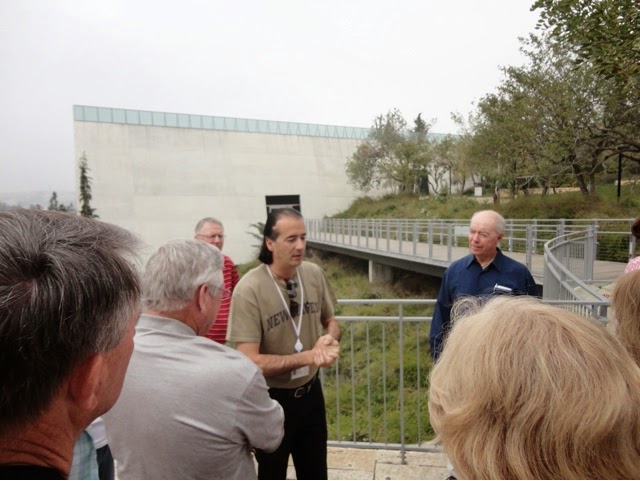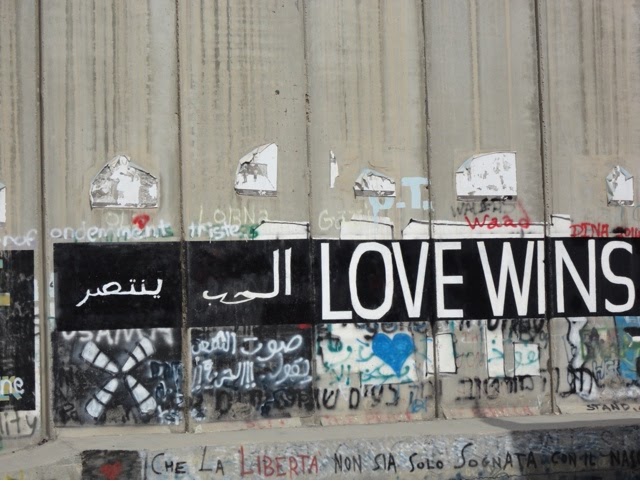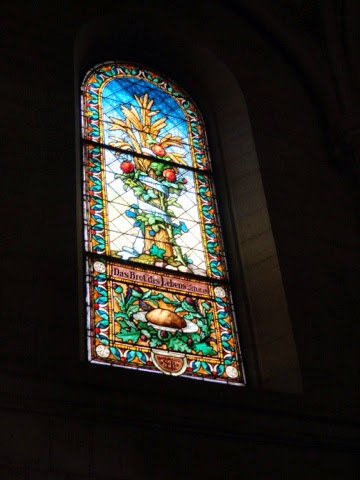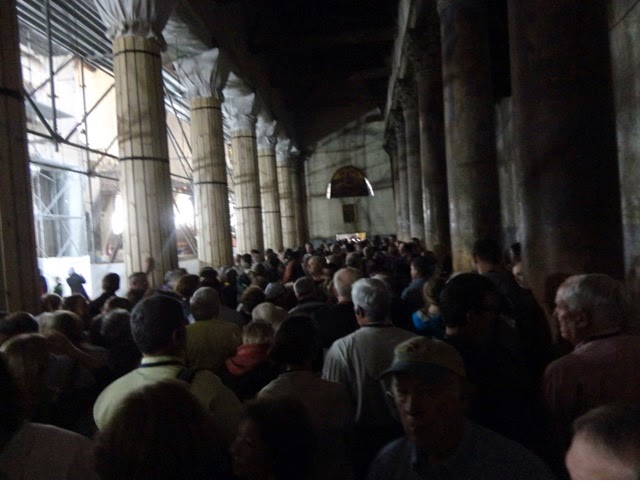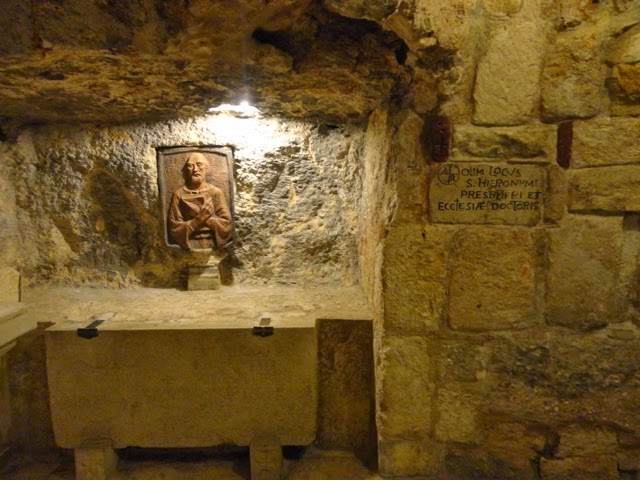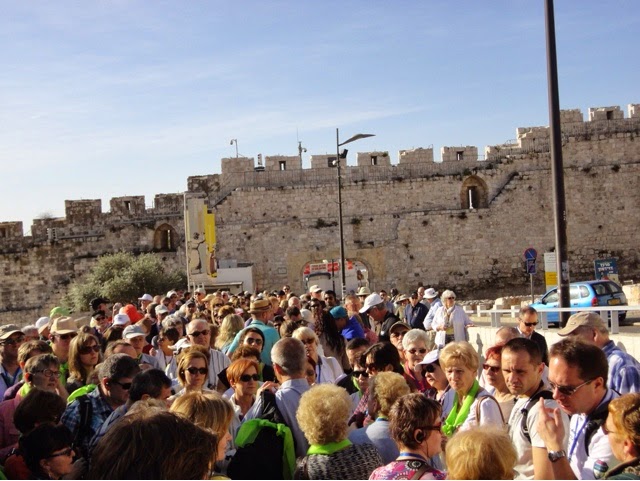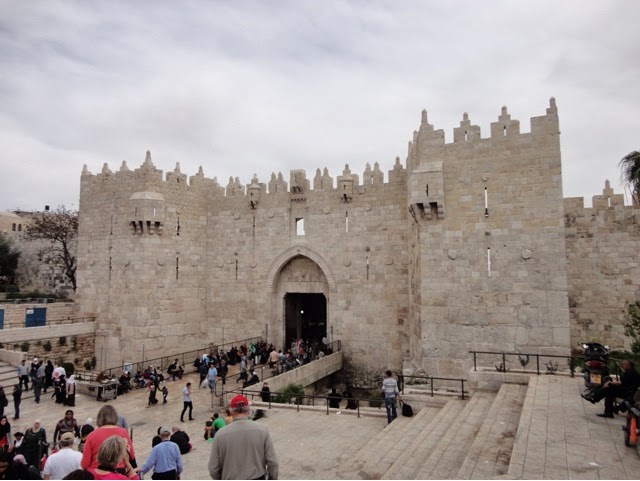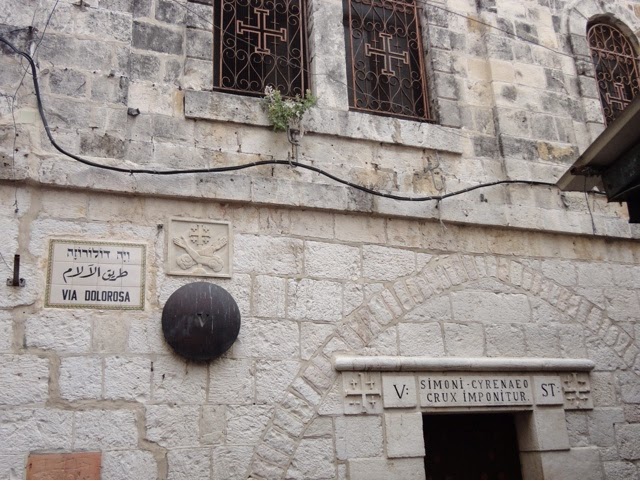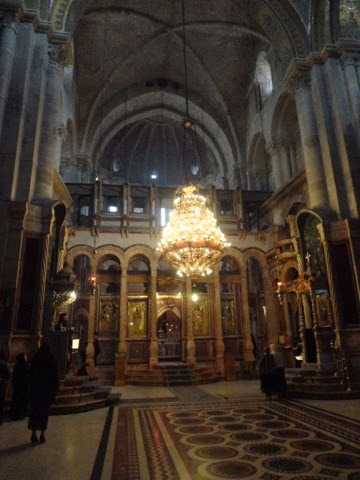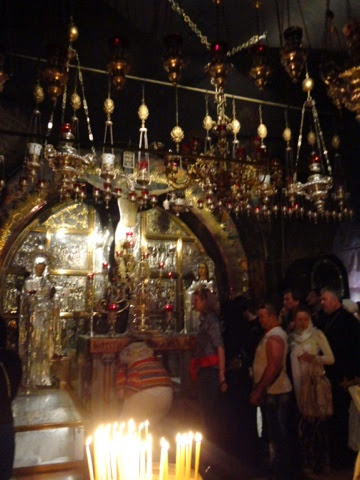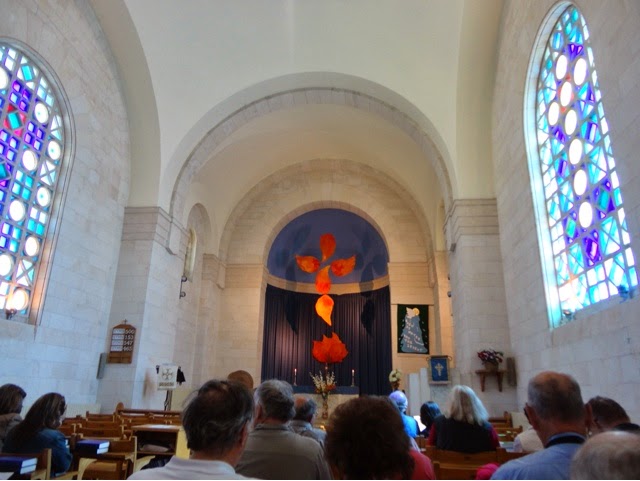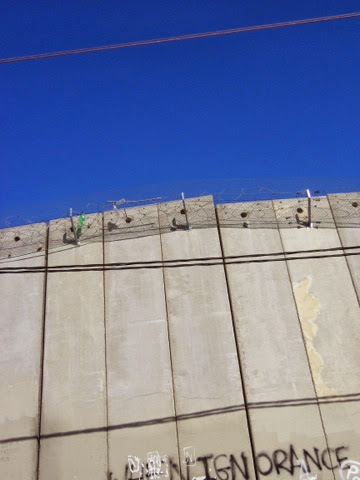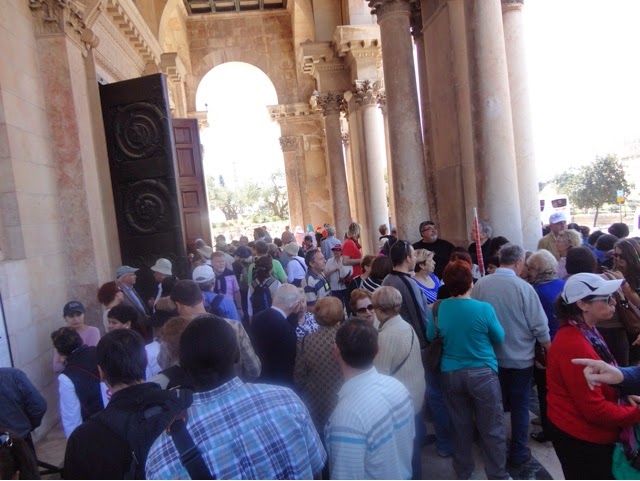The guide called it Holy chaos. That would sum up today. A moving, powerful, and important day. It was sensory overload in the fullest sense. A wonderful and touching day that brought together all the themes which have been swirling around us all week. Bible. History. Archaeology. Complexity of the current situation.
(The line to get into the Temple Mount. This are the people behind us more than 30 minutes before it opened.)
(Our guide in Jerusalem, Peter, tells the group about the unbelievably complex and intiricate history of the Temple Mount, the focal point for the religion and the debate about the Holy City.)
"You are sitting in the most valuable real estate in the world," Peter told us. And yes, it is. So valuable it is controlled by two different security check points. The list of items that Christians cannot bring in is long, long, long. Because, afterall, this Muslim Holy site is sitting atop the holiest site in all of Judaism.
You may go and read the history of the Temple Mount at any time. How it is where Jesus got lost as a boy. How it is where Jesus overturned tables once. How Jesus predicted its destruction. Read about the Wailing Wall, the Western Wall. The Dome of the Rock. Al Asqa. The Holy of Holies. Alll of those things. Right there or near to where our group sat this morning.
(Trying to take it all in. The mound itself is huge. Like a giant park. Only with policemen in riot gear at every gate and with Army soldiers walking around eveywhere.)
In any other time and place it would have been a glorious morning. It might have been a fantastic stroll through a large park. A nice place to take in the hills and elevation changes.
But instead its present state is as complex and convoluted as its past. This site has seen temples come and go. Fires. Wars. The crusaders swept through here killing hundreds upon hundreds on the very stones where we walked. It is a troubled past.
And as we sit there, one Jewish Youth walks past. He cannot be more than 24 years old. He walks a path from which he will not deviate, as he does not want to walk over the site of the Holy of Holies. He is one of only 2 or 3 Jews who might come in today. And as he walks by he is flanked by two soldiers. One a soldier of Israel, making sure that the Youth does not pray, enforcing the no prayer ban handed down years ago. No prayers other than Muslim prayers on the Temple Mount. The second soldier? A member of the Islamic guard which has some jurisdiction at the site observing the Israeli soldier and the Jewish Youth. One kid. Two soldiers. It is a troubled present.
Holy chaos indeed.
The Jews here do pray, of course.
At the Western Wall. At the foot of the Temple Mount.
I prayed at the wall. I touched it. I wrote a prayer for my family. I wrote "Psalm 67" on my paper. And then I tucked it into the wall and closed my eyes and prayed the Psalm as best I could. As I opened y eyes I was next to an old, old, old man who was praying. His face was pressed onto the wall. He was repeating Hebrew phrases. That was to one side. To the other was a young soldier. Praying at the wall. Praying with one hand on the wall and with the other hand on his gun.
I turned around. Very little boys were running around. A huge crowd of boys on a bar mitzah trip came pouring in. And over the wall which separates men and women into two groups at the Western Wall, a young couple held hands over the top of the seperation wall for as long as they dared.
Holy Chaos.
From there to lunch outside of the Old City, and back into the Old City area through the Damascus Gate.
It would not have looked like this in Jesus' time. 2,000 years is a long time. And most of these walls are 15th and 16th century. Hadrian (yep, that Hadrian) once built an arch here spanning the bridge and gate that was long ago torn down.
Inside the Damascus gate is an explosion of sight, sound, smell, color, and commerce. But that is how you get to the Via Dolorosa.
And the great stations of the cross.
When walking the way and walking the roads and streets, elevations are always changing. Layer upon layer of the city needs to be unpealed to understand. There are times when it is hard to tell if you are above ground or underground or under a building.
Up many ramps and flights of stairs sits the Church of the Holy Sepulcher (place of crucifxion and the tomb of Christ) at the end of the journey.
I cannot begin to explain the history here. But six different churches have claimed parts of it. This is so contested that it is actually a Muslim family which keeps the key - the six churches couldn't agree on which one should have the key -- and this has been the case for (I think) at least 1,000 years.
I could write 5,000 words about my feelings being there. It is a crusaders church in every sense. It is simultaneously wonderful to be there -- because there are legends and archaeologists who believe that the hill of crucifixion and the tomb of resurrection are located about 30 yards from each other right here in what now is this massive, ancient, and incredible church.
If you want to be amazed at complexity, do some internet research on the administration of this church.
It is medieval and dark and stuck through agreements to be exactly as it is.
I wish I could give you a clear picture of Calvary hill, but it is covered by the church.
It was probably in or near a rock quarry.
It was on the outside of the walls at the time of Jesus' death.
I was very near a set of 1st Century Jewish tombs.
It was 40 or 50 feet high, though it is hard to tell. The church is built up here upon layers and layers of buildings and levels and levels of city and streets. So when one enters you are already "ascending" the small hill of rock. And then, as you climb the steps of the church you are "ascending" Calvary, or at least the rocks of Calvary.
Imaging building a giant church level by level over a small rocky hill. That is the Church of the Holy Sepulcher, the church which the sanctuaries are built around the hill itself. And what is not built around the hill is built around the tomb.
Remember, it is medieval archtiecture.
So it is dark and very Eastern in style and form.
I found myself saying like many before me, "I am baptized. I am baptized," thanking God for the many promises which keep us.
I found myself praying thanksgivings for the courage of Jesus and for his resurrection.
But I was easily distracted. I think the entire Russian Orthodox Church was there with us. The noise is non stop. So loud it is like a hum. Some are people praying and singing. But a lot is people jockeying in line. Calling on cell phones. Priests trying unsuccessfully to get people to be quiet.
There is a lot of veneration going on.
But it is hard to tell how much sacred is happening.
All around is Holy chaos.
These are the most sacred places of faith. And yet I prayed to God to remind me of Jesus' deepest lessons even in the vicinity of Jesus' greatest acts. Even in the midst of venerated and miraculous sites, I strained to remember his teachings and his words. I tried to remember his lessons. Lessons like the church Jesus loved most was not any one building, but people doing his will, making peace on the earth, proclaiming love, forgiveness, salvation in his name. Lessons like welcoming children, feeding the hungry, and singing joyfully from the heart. The church he loved most is the one which talks about, and prays about, and gives witness to the kingdom of God.
Please don't hear this wrong. These sites and this place is as special as any I can imagine. I tremble when I think of the site of Christ's death. I am awestruck each time I consider resurrection and the promise that knows no end. And to be so close is a rare blessing!
It is just hard to get to the heart of the matter, to the rocks and the word and the words beneath the rocks, to the core of what is most essential here -- it is hard to get to it through all the things that history, squabbles, tradition, have added onto it. Jesus came to build a church in our hearts, and one has to peel back the layers of the ones we see to remember this. Or, if you'll allow, the way this has been built and handed on century after century after century -- it can be difficult more difficult than necessary to see Jesus, the living stone, because of the stones of the church building itself.
As I write at the end of a long day, I think back to Bible school at the Episcopal Church, the Baptist Church, and sometimes with friends, at other churches. It seemed we always sang, "I am the church, you are the church, we are the church together," no matter where we were. Good reminder that God seems to care a great deal about the living stones of faith. A great deal indeed. I left wondering about the church I will leave behind one day to my family and community. I left wondering about my ministry. In light of the power of resurrection promise, and in light of the call of Jesus to follow, how am contributing to the building up of the living stones in my midst?
Again, Peter put a good end to the day of Holy chaos. "No matter what else, good, bad, easy, hard -- all of this happened because of Jesus and what he gave to the world."
Should you come here, remember this. This city is disorienting for a simple guy like me. There are traditions and mysteries here older than any memory. Every inch of the dirt unlocks secrets. Level upon level. The interwoven nature of Bible, tradition, history, liturgy, practice, and politics is knotted and tight. It is impossible to seperate one from another.

(Look at this photo. I know 1% of what I am looking at. But look at it. In the background are all the Jewish graves facing the "golden gate" of Jerusalem - graves on the Mount of Olives. Before us is a compound that runs parallel to the southern wall of the Old City. This whole compound is a dig and discovery site. Once the 15th / 16th century walls stop to the left - the high ones - do you see how other walls keep going just on the ground in front of it and perpendicular to it? Notice that they are deeper. Now imagine those partial walls and all that you see there as being under streets, under ground, under buildings. Can you see those two arches in the left third of the picture, under the gray dome? Those would have been tunnels, or breezeways, or something, but they would have been understreet, underfoot, underground at some point as well. And then to the right another wall, built by who or when, I have no idea. And this is just one site. So in this city, levels beget levels. Maps beget maps. It is the archaeological puzzle of lifetimes! And many of the sites we visit go up and down, all through these levels to reach the level where things were 2,000 years ago. It is like Holy archaeological chaos. I have always appreciated archaeologists. My respect for them has exponentially increased on this trip.)
But in the midst of the chaos and the crowding, a good reminder sets the heart and the mind and the soul on a good path.
A path that leads to a cross. The real one, yes, but also the ones we carry with us.
And a path which leads to empty tombs. The real ones, yes, but so too the ones we carry with us.
Destinations count. So do journeys. This trip has been a fine reminder of as much.
Are their answers to be found here? Of course. But one doesn't have to come here to find them. Find the answers -- find them somewhere between the difficulty of sacrifice and the loveliness of grace, between the paradox of suffering and the power of hope.
Jerusalem, it seems, for all its permanence, exists in this liminal space.
Addendum:
Like each day since we arrived, it is hard to know what to write about. Each day SO many things happen. Each day we see SO many biblical and historical keystones.
I want to share some quieter moments with you. A Korean Youth choir sang Amazing Graces at St. Anne's church, sitting next to the pool of Bethesda (John 5). A WMPC choir member actually joined in and sang with them. It was amazing and simple and lovely. Best acoustics in the Holy Land we were told. They didn't disappoint.
We worshipped at the Church of Scotland today. St. Andrew's. Lovely old church and lovely people. Pretty sanctuary to boot.
Then at 5 PM (our time) we worshipped again. With a very familiar congregation!
And there you have it.
Sunday in Jerusalem. It began with bells ringing all over the city. Old fashioned church bells.
Holy chaos and divinely inspired calm...

